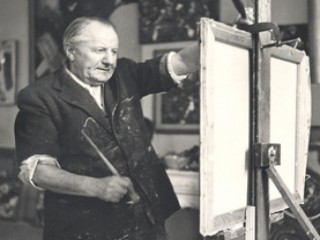
Hans Hofmann biography
Date of birth : 1880-03-21
Date of death : 1966-02-17
Birthplace : Weissenburg, Germany
Nationality : German-American
Category : Arts and Entertainment
Last modified : 2011-06-07
Credited as : Artist painter, cubism and Fauvism, abstract painting
The German-American painter Hans Hofmann approached abstract painting through cubism and Fauvism. His teaching and painting were singularly influential for the development of American painting after 1945.
Born in Weissenburg, Germany, Hans Hofmann studied music and science before enrolling in 1898 at Moritz Heymann's Munich art school. Hofmann's early work was influenced by Wilhelm Leibl's impressionism and by French neoimpressionism. His pencil studies at this time also suggest an unusual preoccupation with the relationship of figures to their ground planes.
From 1904 to 1914 Hofmann, sponsored by a Berlin art collector, studied in Paris. He met many cubist and Fauve artists and was drawn particularly to Robert Delaunay's abstractions. When World War I began, Hofmann's patronage ended, and he returned to Munich.
Because of a lung ailment, Hofmann was not drafted. He opened an art school in Munich in 1915, and for the next 15 years he articulated a philosophy of art based on Fauvism and cubism; in particular, he sought to redefine Paul Cezanne's two-dimensional picture plane in terms of light. Hofmann's concern with his students' development often took precedence over his own work. By the 1920s his reputation as a teacher was assured, and his school began to attract students from America, including Al Jensen, Louise Nevelson, and Carl Holty.
The political climate of postwar Germany made it increasingly difficult for Hofmann to maintain his school, and in 1930 he accepted an invitation to teach a session at the University of California. He returned to California the following summer, and in the fall he moved to New York City, where he joined the faculty of the Art Students League. In 1932 he opened his own art school in New York, with summer sessions at Provincetown, Mass.
Although Hofmann virtually abandoned painting until the late 1930s, a few examples from his Munich period survive. His work from 1915 to 1930 suggests his increasingly critical interpretation of cubism and Fauvism. In the mid-1920s a new interest in free-form motifs that seems to derive from Wassily Kandinsky appears. Although more relaxed, Hofmann's composition is never loose; the newly expressive forms are controlled by the planar integrity learned from Cezanne and synthetic cubism. Apples (1931) shows this approach.
Hofmann's essay, "Plastic Creation, " in the League (1932-1933) is his first important statement made in America concerning the function of two-dimensional picture space. In it he articulated an academic approach that had far greater impact than his few paintings of the early 1930s. However, for Hofmann, the possibilities of painting always encompassed divergent approaches; the geometric and the curvilinear, the thickly impasted and the thinned surface were all concurrently viable throughout his career, although there were periods when one set of problems seemed to take precedence over another, such as in his 1941-1943 landscape studies.
Hofmann's work beginning in the 1940s received great critical acclaim. In 1944 he exhibited at the influential Art of This Century Gallery in New York. Interest grew for works such as Spring (1940) and Fantasia (1943), which, in their innovative dripped and curvilinear forms spreading across the picture surface, substantiate the claim that Hofmann was a founder of automatism in American painting. In 1948 Hofmann was given a retrospective exhibition in Andover, Mass. At this time the publication of his selected writings provided explanations of the paintings and inspired a generation of younger American artists.
Although Hofmann continued to teach until 1958, he found more and more time for his painting and discovered new motifs in the work of younger painters. Apparition (1947) recalls Jackson Pollock, with its anthropomorphic shapes emerging from the scrambled background. At the same time, Hofmann could rethink Henri Matisse, as in Liberation (1947), in which the paint is thinned down and delicately contained within the outlines, or in Magenta and Blue (1949-1950), in which both color and relationship of figure to ground plane paraphrase Matisse.
Hofmann's reputation was firmly established by the 1955 and 1957 retrospective exhibitions given at Bennington College and the Whitney Museum. So too did his interests diversify and expand; technical virtuosity characterized his last decade. In his late 70s he retired from teaching to devote full time to painting. His message of "push and pull" against the picture plane is convincingly worked out in The Gate (1959), in which not only are the geometric shapes set in parallel planes but the palette knife and the brushstroke work to the same end. Comparing this painting with The Conjurer (1959), with its billowing forms and intense color range, again suggests the diversity and genius of Hofmann's art. Agrigento (1961), in the monumental simplicity of the monochromatic hue and the wide sweeping brushstroke, suggests that in spite of Hofmann's complex artistic theories he was able to express a visual experience directly with a minimal amount of intellectualizing.
While Hofmann's success as a teacher can be judged by the success of his pupils, his own paintings and writings establish him as a major force in contemporary American painting. He died in New York.


















